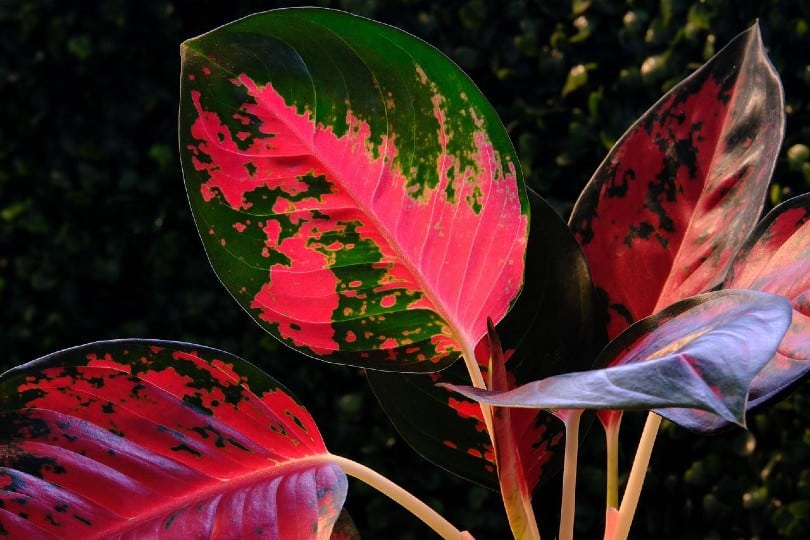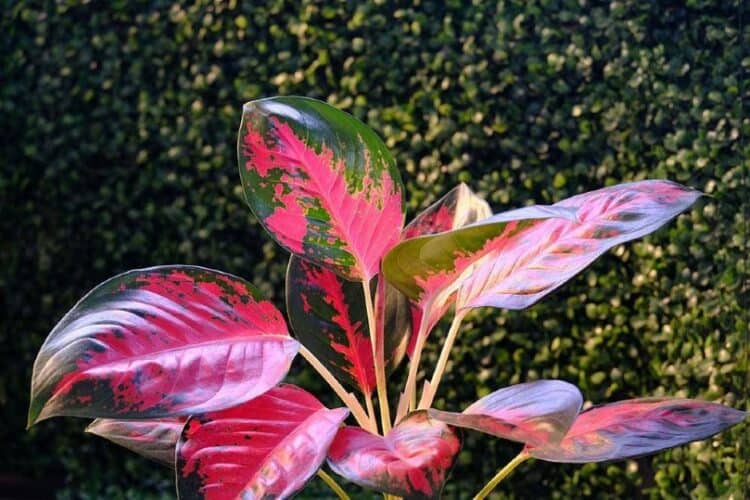Aglaonema, commonly called Chinese Evergreen, is a popular tropical houseplant thanks to its ability to grow in low light and colorful foliage. If you have cats, however, you might wonder if this plant is safe to grow around your kitties. Is Aglaonema toxic to cats?
Yes, Aglaonema is toxic to cats, as are most plants in this family (Araceae.) In this article, we’ll tell you why the plant is unsafe for cats and what you should do if they eat one. We’ll also suggest some non-toxic plants you could consider growing to keep your cat safe.
Why Is Aglaonema Toxic To Cats?
According to the Pet Poison Helpline, Aglaonema contains a substance called insoluble calcium oxalate crystals. These crystals are sharp and piercing but do not dissolve in liquid, meaning they don’t enter the cat’s bloodstream and affect other body systems. Because of this, Pet Poison considers Aglaonema a mild to moderately toxic plant.
When a cat chews on the leaves of the Aglaonema, the calcium oxalate crystals are released, causing painful irritation to the mouth. If swallowed, the crystals can further irritate the rest of the cat’s digestive system.
What To Do If Your Cat Eats Aglaonema
If your kitty chews on the Aglaonema plant, you may notice one or more of the following symptoms:
- Drooling
- Loss of appetite
- Vomiting
- Pawing at the mouth
- Mouth pain
While it rarely occurs, eating this plant could also cause swelling in your cat’s upper airway, leading to trouble breathing.
If you notice any of these symptoms, contact your veterinarian. Try to bring a sample of the plant with you to your vet’s office so they can confirm the identification. Never try to make your cat vomit or treat them at home without first speaking to a veterinarian.
Once your vet confirms what is causing your cat’s symptoms, they will likely suggest symptomatic treatment. Aglaonema toxicity is primarily uncomfortable rather than life-threatening. However, any time a cat stops eating for a period, it can lead to further, more serious complications.
Of course, if your cat seems to have trouble breathing, they need to see a vet right away.

Keeping Your Cat Safe From Aglaonema
The easiest way to keep your feline safe from Aglaonema is to keep it out of the house entirely. Choose a more cat-friendly plant to satisfy your green thumb. Some flowers and plants that are considered safe for cats include:
- Boston fern
- Spider plant
- Friendship plant
- Zebra hawthoria
- Roses
- Orchids
- Gerber daisies
If you still want to grow an Aglaonema, keep it in a room that’s off-limits to your cat. Even better, consider adding one of these plants to your office. They are ideal office plants because they grow well in low light and can even thrive in fluorescent lighting.
Conclusion
If you’re beginning your journey with house plants, Aglaonema is a hardy, low-maintenance option. Unfortunately, they don’t mix well with our feline friends, and cat lovers will need to look elsewhere. Besides the plants we listed, the ASPCA maintains an extensive list of non-toxic plants you can consider growing. Be sure to double-check any potential plant purchase with this list or with your veterinarian to keep your kitty safe.
Featured Image Credit: Pixabay














